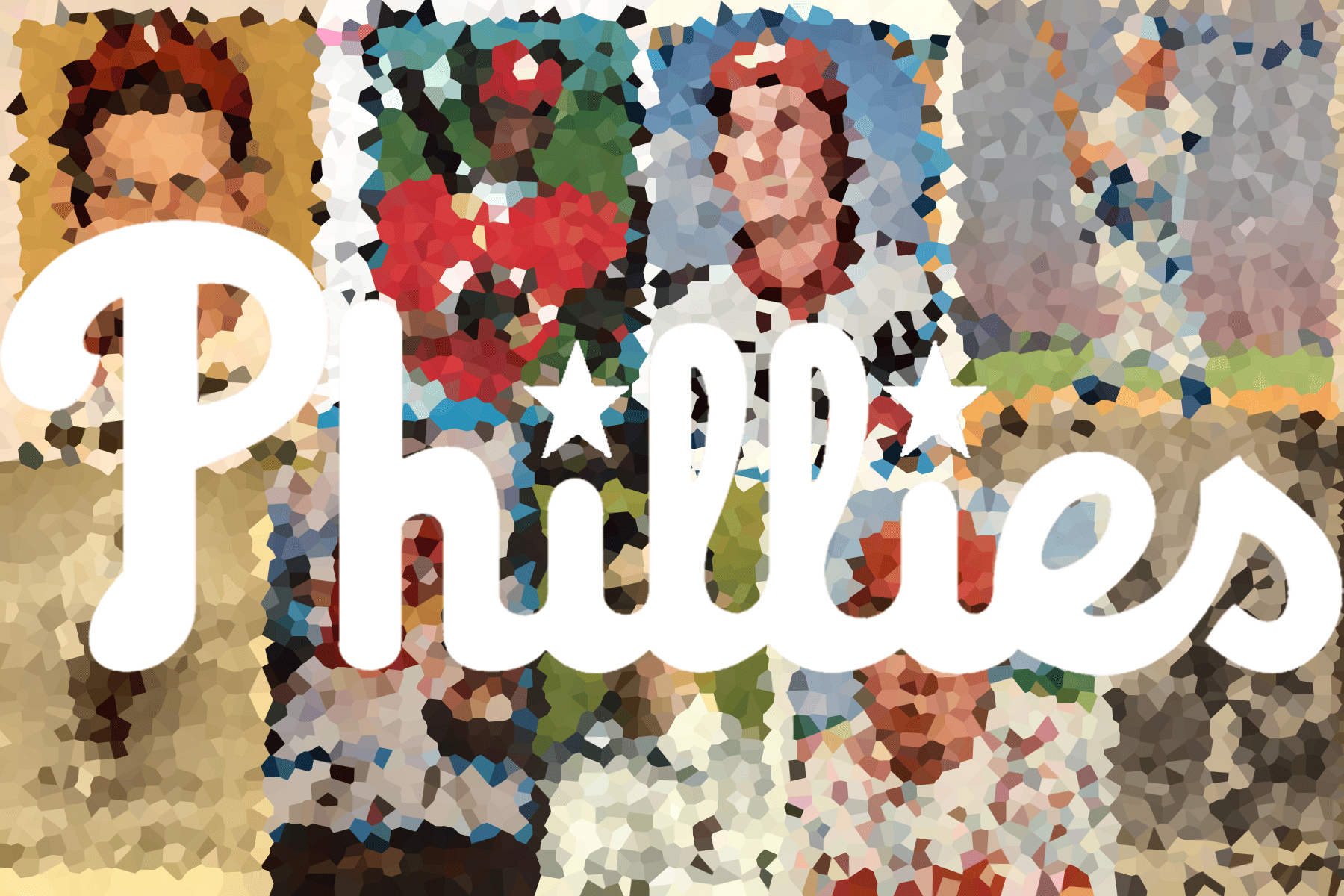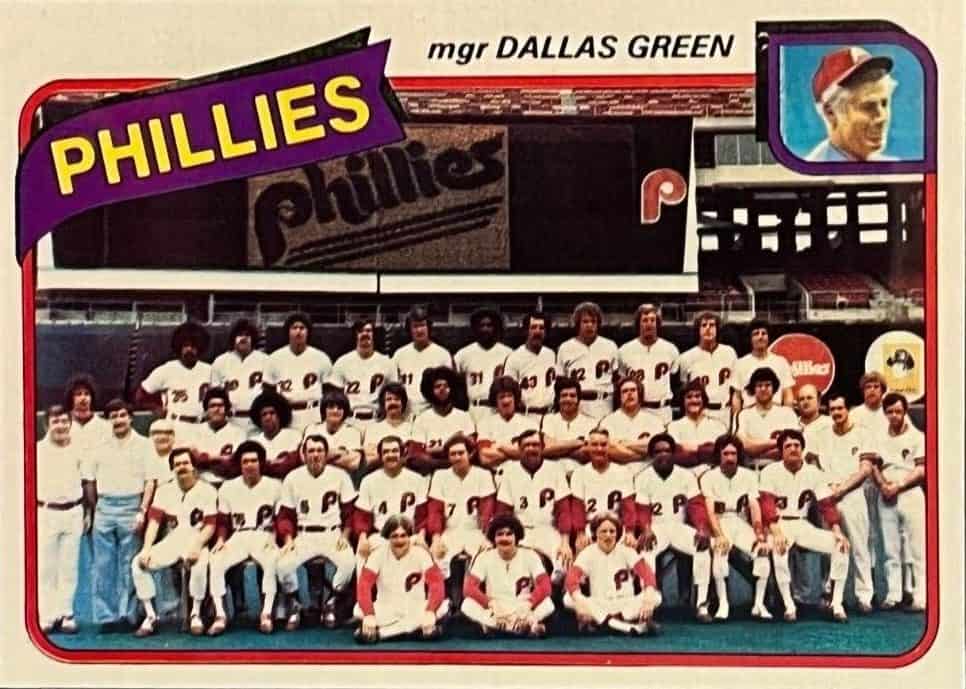
The Philadelphia Phillies, founded in 1883, are one of the oldest and most storied franchises in Major League Baseball. In their early years, the team was known as the “Quakers” and later as the “Phillies.” In 1887, they won their first pennant in the American Association. The team’s fortunes fluctuated throughout the late 19th and early 20th centuries, but they finally captured their first World Series championship in 1980. Thousands of players have put on a Philadelphia uniform – Here are the 10 best, and their best Phillies cards.
10. Chuck Klein
Chuck Klein joined the Phillies in 1928 and spent his career with the team until 1933, and then again from 1936 to 1939. During his time in Philadelphia, he established himself as one of the most feared hitters in baseball.
Klein was a four-time All-Star during his Phillies years and won the National League Triple Crown in 1933, a rare feat that saw him lead the league in batting average, home runs, and runs batted in. His incredible power at the plate and his ability to consistently drive in runs made him a fan favorite. In 1930, Klein achieved one of the most remarkable feats in Phillies history – He recorded 250 hits, a record that still stands today. His contributions to the Phillies were instrumental in shaping the team’s identity and laying the foundation for future success. Klein is in the National Baseball Hall of Fame, Class of 1980.
Best Phillies card: Chuck Klein had few baseball cards. His most prominent were his rookie cards from 1925-31 Exhibits (there were five) and his 1933 Goudey issue. The Exhibits cards are hard to find; the few that have been catalogued by PSA are in the $100 range. The accuracy of that price likely suffers from a small sample size. The 1933 Goudey is more common and costs around $2,000 for a PSA 7 or PSA 8.
9. Grover Cleveland Alexander
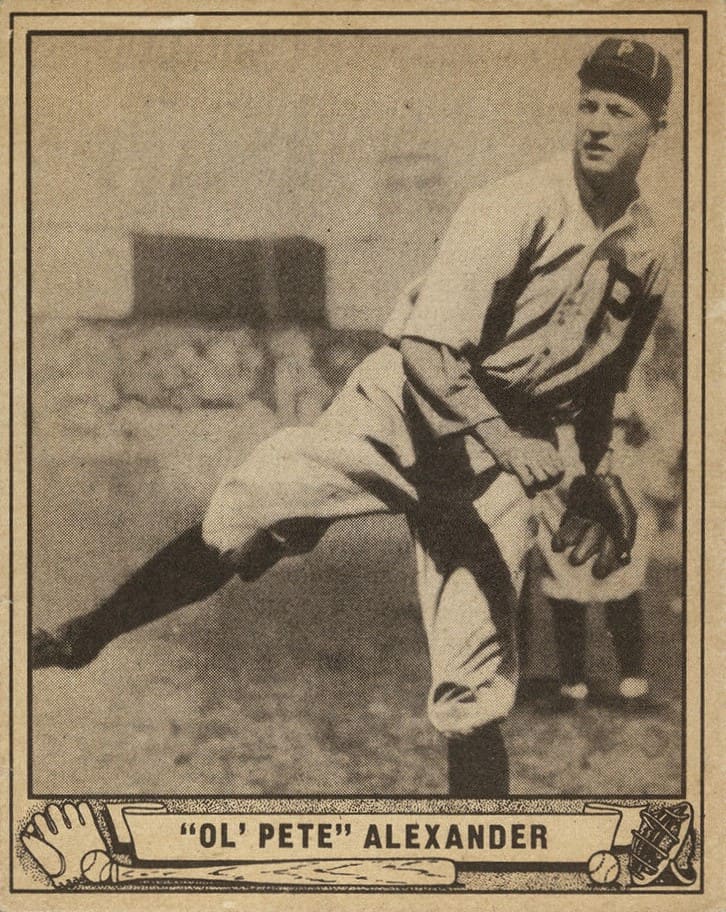
Grover Cleveland Alexander, affectionately known as “Old Pete,” joined the Phillies in 1911. He quickly became one of the most dominant pitchers in baseball. His time in Philadelphia, which lasted until 1917, was marked by unparalleled success on the mound. He won 30 or more games three times during his Phillies career, showcasing remarkable consistency and durability.
Alexander was a vital part of the Phillies’ pitching staff, helping the team become a force in the National League. His pitching prowess was instrumental in the Phillies’ runner-up finish in the 1915 World Series. Alexander’s impressive performance for the Phillies (and other teams) ultimately earned him a place in the Baseball Hall of Fame.
Best Phillies card: Owing to his popularity, Alexander had more baseball cards than many of his contemporaries from the 1910s. However, he doesn’t have a lot of Phillies cards. His most popular and attainable card is the 1940 Play Ball #119 from his post-playing days. It sells for under $1,000 in fair to very good condition.
8. Cole Hamels
Cole Hamels, a left-handed pitching sensation, made a significant impact from 2006 to 2015. He emerged as one of the premier young pitchers in baseball and was a vital contributor to the Phillies’ golden era, including their 2008 World Series championship. His pitching earned him the World Series MVP award, and his memorable pitching in crucial moments helped end the Phillies’ 28-year championship drought.
Known for his precise control and a devastating changeup, Hamels became a fan favorite. He earned the nickname “Hollywood” for his confident and composed demeanor on the mound. Over the course of his Phillies career, Hamels was selected to three All-Star Games.
Best Phillies card: Hamels’s rookie card is the 2002 Bowman Chrome #BDP-17, which costs approximately $30-$50 for a PSA 10.
7. Jimmy Rollins
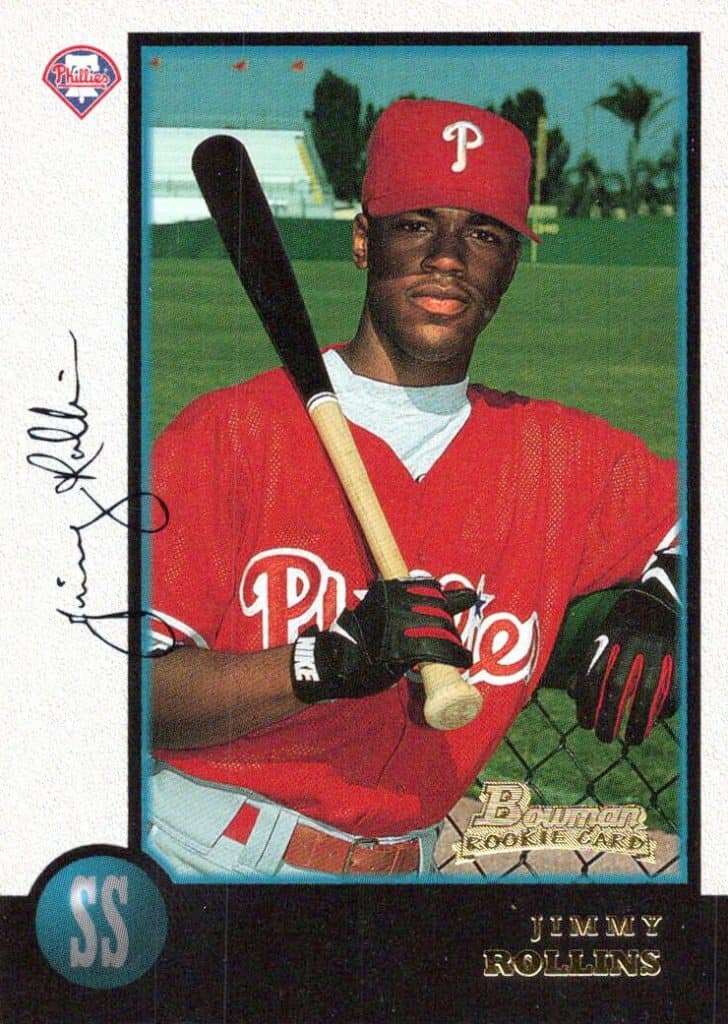
Jimmy Rollins, affectionately known as “J-Roll,” played for the team from 2000 to 2014. Rollins was a key figure in the Phillies’ resurgence in the mid-2000s. He helped lead the team to five straight NL East titles, two NL pennants, and the 2008 World Series championship. His leadership, speed, and dazzling defensive plays at shortstop made him a fan favorite. He earned him the reputation of being the heart and soul of the team.
In 2007, Rollins famously declared the Phillies as the “team to beat” in the division. This was a proclamation that he backed up by winning the National League MVP award that season. He was a three-time All-Star during his Phillies career and set several franchise records, including most hits and runs scored. Rollins was not only an exceptional athlete but also a respected leader in the clubhouse. His tenure in Philadelphia made him a beloved figure in the city’s sports lore.
Best Phillies card: Like Hamels, Jimmy Rollins’s rookie card – 1998 Bowman #181 – is easy to come by for about $50. The 1998 Bowman Chrome and refractors are slightly more expensive but still a good value rookie card.
8. Sam Thompson
Sam Thompson, often known as “Big Sam,” was a standout player for the Philadelphia Phillies during the late 19th century. Thompson joined the Phillies in 1889 and quickly established himself as one of the premier power hitters of his era. His tenure in Philadelphia lasted until 1898 and he was a key figure in the early history of the Phillies.
Thompson was known for his remarkable slugging ability, which was particularly impressive considering the dead-ball era in which he played. In 1889, he led the league in home runs and RBIs, becoming one of the first players in baseball history to achieve such a feat. His aggressive and powerful approach at the plate made him a fan favorite. He was inducted into the Baseball Hall of Fame in 1974.
Best Quakers card: Sam Thompson’s best Phillies (Quakers) card… kind of isn’t. In 1887, when Thompson was playing in Detroit, he posed for a series of 1887 Old Judge N172 cards. When he moved to Philadelphia in 1889, Old Judge reissued the same cards, with “Philadelphia” pasted across his chest. It’s an early Photoshop that makes for great trivia. There aren’t a lot of documented copies of these cards. Generally, if you find one, they will be priced in the $1,000s to $10,000s (fair to good condition).
7. Sherry Magee
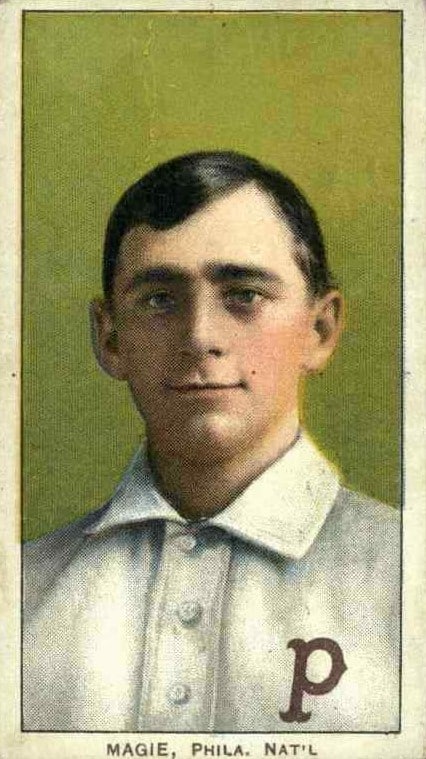
Sherry Magee, known for his hard-nosed playing style and aggressive base-running, was a standout player for the Phillies during the early 20th century. Magee played for the Phillies from 1904 to 1914, becoming one of the franchise’s first true stars.
Magee was known for his fiery demeanor and his competitive spirit. This earned him a reputation as one of the toughest players in the league. In 1910, he led the National League in RBIs and batting average. Magee’s contributions were instrumental in the Phillies’ success during his time.
Best Phillies card: Sherry Magee played for the Phillies for a decade, but his best card is part of the legendary 1909 Piedmont T206 set. Two versions exist, with the first being a rare error version with his name spelled as “Magie” instead. The corrected version is much more common (priced around $2,000 vs. $40,000).
6. Chase Utley
Chase Utley was a pivotal figure in the Philadelphia Phillies’ resurgence during the mid-2000s. Utley spent the majority of his illustrious career with the Phillies, playing for the team from 2003 to 2015. He was renowned for his gritty and hard-nosed style of play, making him a fan favorite. His tenure in Philadelphia coincided with a period of remarkable success for the franchise, including two NL pennants and a World Series championship in 2008.
Utley was a six-time All-Star and a four-time Silver Slugger Award winner during his Phillies career. Known for his consistent hitting, exceptional fielding, and baseball intelligence, he was a linchpin in the heart of the Phillies’ lineup. Sometimes fans underrate players of the 90s and 2000s, and Utley might be one example. His 64.5 WAR is the 15th best all-time among second basemen.
Best Phillies card: Chase Utley’s true rookie card is the 2001 Bowman Draft #BDP-69. A near-mint version sells around $100, according to PSA. There is a corresponding Futures Game relic card from the same year.
5. Richie Ashburn
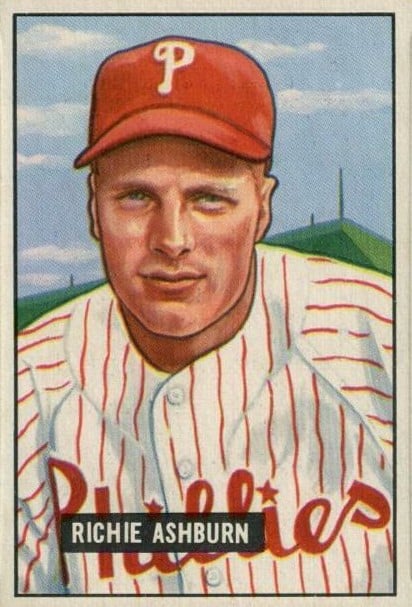
Richie Ashburn played for the Phillies from 1948 to 1959. His presence in the outfield was both electrifying and dependable. Known for his exceptional defensive skills, he won two Gold Glove Awards and became a standard of excellence in center field. Ashburn’s knack for tracking down fly balls, often in acrobatic fashion, made him one of the greatest defensive outfielders of his era.
In addition to his remarkable fielding, Ashburn was a consistent and talented hitter. He led the National League in batting average twice during his Phillies career and was a four-time All-Star. His ability to get on base and create scoring opportunities was instrumental in the Phillies’ success; off the field, Ashburn’s affable personality and connection with the fans endeared him to the people of Philadelphia. Richie Ashburn’s time in Philadelphia is celebrated not just for his on-field contributions but also for the enduring impact he had on the franchise and its passionate fan base. Ashburn was elected to the Hall of Fame in 1995.
Best Phillies card: Richie Ashburn’s rookie card is the 1949 Bowman #214, but it’s not his best. That honor goes to the classic 1951 Bowman #186, which is a full-color, glossy design that does the Phillies and Ashburn better than his true rookie. A PSA 8 of this card is priced at $290, per PSA, but jumps wildly to $3,000 for a PSA 9.
4. Robin Roberts
Robin Roberts, a dominant right-handed pitcher, played a pivotal role in the Philadelphia Phillies’ success during the 1950s and early 1960s. Roberts’ tenure with the Phillies spanned from 1948 to 1961, making him one of the longest-tenured players in franchise history. Renowned for his workhorse mentality and his impressive ability to throw complete games, he epitomized the “ace” of a pitching staff.
Roberts was consistently outstanding, earning six All-Star selections and leading the National League in wins for four consecutive seasons. His remarkable durability and unyielding competitiveness helped the Phillies contend for the National League pennant in 1950, marking their first World Series appearance in 35 years. Roberts was inducted into the Hall of Fame in 1976.
Best Phillies card: Like Ashburn, Roberts’s rookie card is the 1949 Bowman #46, but his best card is the 1952 Topps #59. This was the year he won 28 games, threw 330 IP and finished second in MVP voting. He also had a league-leading 8.6 WAR. Roberts was untouchable. A PSA 10 of this card has never been recorded, but expect to pay around $250-$1,000 for a PSA 7 or PSA 8.
3. Ed Delahanty
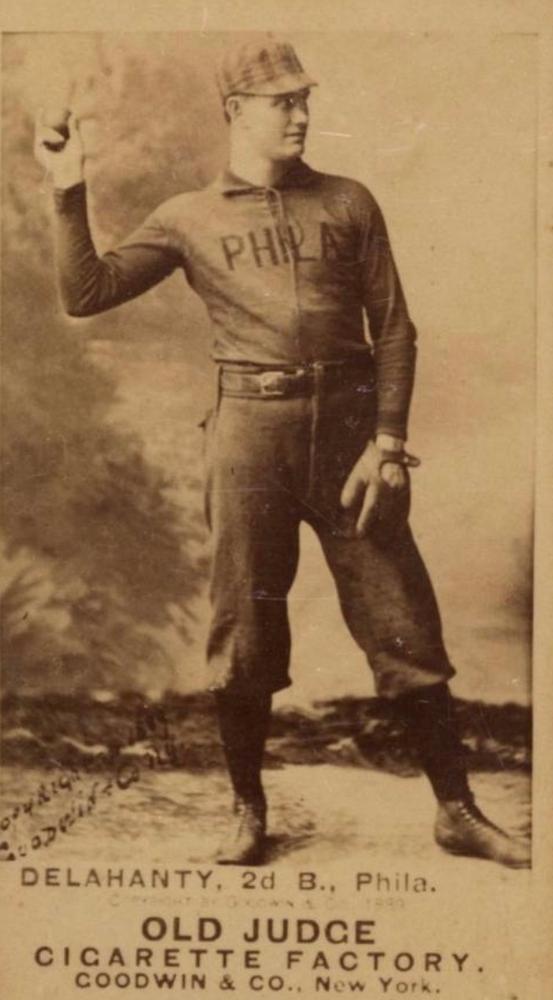
Ed Delahanty, often referred to as “Big Ed,” was one of the most dominant hitters of the late 19th and early 20th centuries, and he had a profound impact during his tenure with the Philadelphia Phillies from 1888 to 1901 (with a quick stop in Cleveland in 1890). Delahanty was a prolific and versatile slugger, capable of hitting for both power and average. His batting prowess, combined with his keen batting eye, saw him capture two National League batting titles during his Phillies career.
Delahanty’s standout moment came in 1899 when he became the second player in history to hit four home runs in a single game. This remarkable feat only added to his reputation as one of the premier power hitters of his era. Known for his ability to consistently drive in runs and deliver in clutch situations, Delahanty was a perennial fan favorite in Philadelphia. Delahanty was elected to the Hall of Fame in 1945.
Best Quakers card: Cards from Delahanty’s playing days are extremely hard to find. Most of the ones in existence are from the 1887-1889 Old Judge sets, where he’s featured in several poses. Delahanty cards rarely come up for auction, and when they do, their condition is extremely poor. Expect to pay at least $10,000 as a starting point.
2. Steve Carlton
Steve Carlton, affectionately known as “Lefty,” had a legendary and transformative tenure with the Philadelphia Phillies, which spanned from 1972 to 1986. His acquisition by the Phillies in a 1972 trade with the St. Louis Cardinals marked a turning point in the franchise’s history. Carlton quickly emerged as one of the most dominant pitchers in the league, displaying remarkable control and a devastating slider that baffled opposing hitters.
During his Phillies career, Carlton won four Cy Young Awards, earned ten All-Star selections, and led the league in strikeouts five times. His superlative performance was a driving force behind the Phillies’ rise to prominence in the 1970s. Carlton’s most significant moment came in 1980 when he led the Phillies to their first-ever World Series championship. He was named the World Series MVP, solidifying his place as one of the all-time greats in the franchise’s history. Carlton was elected to the National Baseball Hall of Fame in 1994 with over 95% of the vote – one of the highest tallies ever.
Best Phillies card: Steve Carlton’s first several years were in St. Louis before he was traded in 1972. His 1972 Topps card features him in a Cardinals uniform (he was traded in February 1972) but his 1972 Topps Traded #751 sets the record straight and is his first Phillies card. This was the beginning of Carlton’s superstar second act. The card is between $100-$300 for a PSA 7 or PSA 8.
1. Mike Schmidt
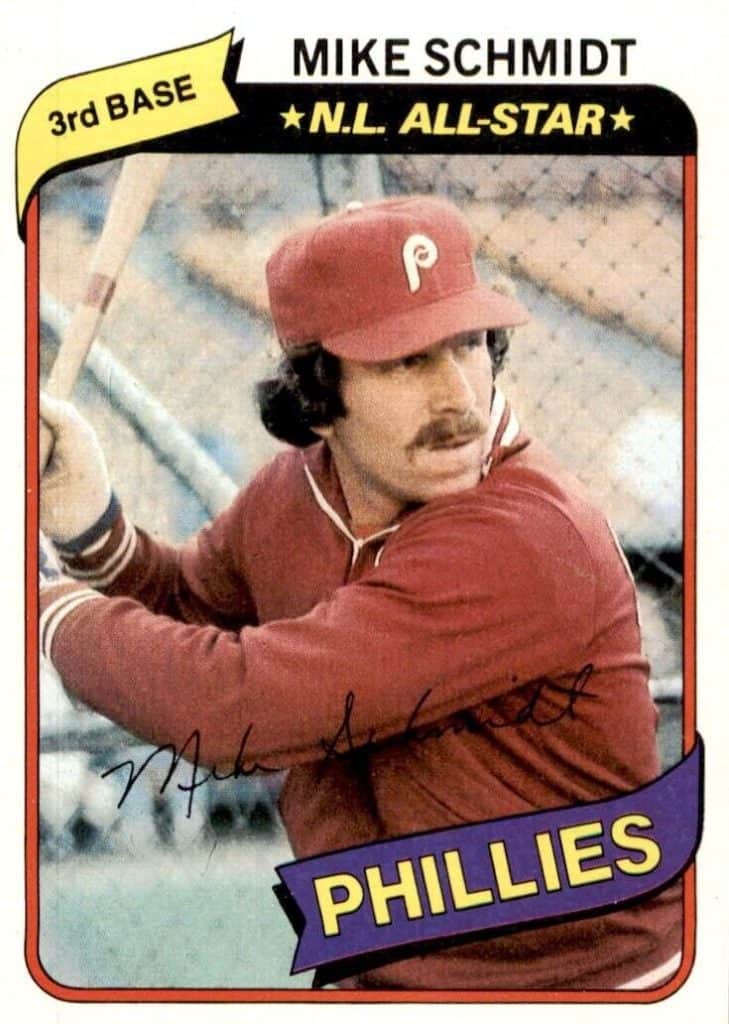
Mike Schmidt is widely regarded as one of the greatest third basemen and power hitters in baseball history. Schmidt’s tenure with the Philadelphia Phillies began in 1972 and lasted until his retirement in 1989. He was the cornerstone of the Phillies franchise for nearly two decades and was instrumental in transforming the team into a perennial contender.
Schmidt’s remarkable career includes three National League MVP awards, 12 All-Star selections, and 10 Gold Glove Awards for his exceptional defense at third base. He was known for his prodigious home run hitting, amassing 548 career home runs, a record for third basemen that stood for many years. Schmidt’s defining moment came in 1980 when he led the Phillies to their first World Series championship, winning the World Series MVP award. He was a first ballot Hall of Famer, elected in 1995 with nearly 97% of the vote.
Best Phillies card: Schmidt’s rookie card is a three-panel shared with Ron Cey and John Hilton, which isn’t befitting one of the greatest third basemen of all time. Therefore, the 1980 Topps #270 is the best way to celebrate a Phabulous year, and one of Schmidt’s best Phillies cards. In addition to winning the franchise’s first World Series, Schmidt was also the NL MVP with 100% of the votes, an All-Star, a Gold Glover and a Silver Slugger. This card is an incredible value at $2-$5 for ungraded versions and a great way to remember that 1980 championship. If you want something more expensive, Mike Schmidt’s rookie card has sold as high as $234,000 for a PSA 10 (according to PSA), but a more reasonable PSA 7 or PSA 8 will cost around $500-$1,500.
